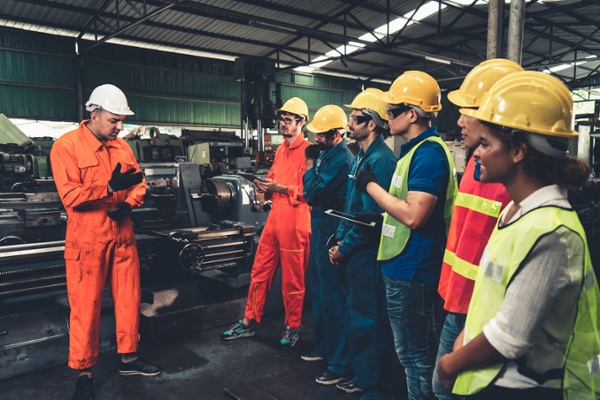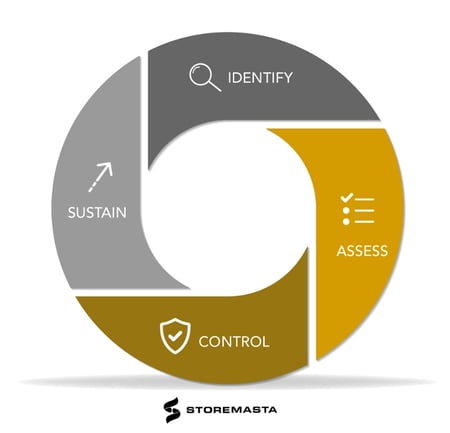When identifying chemical hazards at your workplace you may need to conduct a risk assessment on your work processes to determine if any additional hazardous substances could be generated as by-products, waste, or residue. This blog will help you determine if your workplace is likely to have an exposure risk to hazardous substances generated by your workplace and the steps you need to take to identify, assess, and control the hazards.
Steps to Hazardous Substance Safety
It’s not only hazardous substances and dangerous goods that present a risk in workplaces. Substances like welding fume, grain dust, and diesel exhaust don’t arrive labelled and packed with a Safety Data Sheet (SDS). In many workplaces, the health effects and risks surrounding hazardous chemicals of this nature are not fully understood – with precautions such as ventilation, personal protective equipment and other risk control measures not adequately considered.
The following steps will help you determine how to identify, manage and sustain hazardous chemicals in your workplace to improve the health and safety of your team.
STEP 1: Understand How Hazardous Materials in the Workplace are Generated
It’s important to have a real understanding of all the hazardous substances likely to be present at your workplace because you have a legal obligation to manage the risks associated with all of them.
At your job site, hazardous chemicals could be generated in two ways:
- During a work process: eg, wood dust from using a lathe, sander, or saw; welding fume in the breaching zone of welders; solvent vapours from glues and adhesives.
- As a form of waste or residue: eg, hydrogen sulphide from sewerage; carbon monoxide and other toxins in diesel exhaust; carbon emissions from primary materials manufacturing (iron, steel, cement, paper, petrochemicals).
REMEMBER: A hazardous substance generated in the workplace can harm more than your workers. Hazardous substances can also impact waterways, livestock, flora and fauna on adjoining properties, as well as the atmosphere.
STEP 2: Refer To Reliable Sources for Known Chemical Hazards
Once you have an idea of how work processes and waste materials can contribute to chemical hazards, you should consult reliable external sources for more information about the substances likely to be present at your own job site.
We recommend consulting the following sources for information about the hazardous materials in the workplace:
1. Manufacturers, Suppliers and Importers
The manufacturer, supplier or importer of hazardous chemicals will provide you with a safety data sheet (SDS) for each substance you use, store, or handle at your worksite.
While safety data sheets will detail the toxicology, health and physical hazards of the chemicals, there may not be full details of the hazards associated with smoke and fume, reactions with incompatible substances, and waste by-products. Personal protective equipment, suitable storage, firefighting equipment and other safety information will also be listed in the safety data sheet.
Talk to your supplier to gain a better understanding how individual chemicals react during different processes, climates, and working conditions. They can also indicate any industrial uses that create emissions, or by-products in the form of smoke, vapours, dusts and fume.

It's important to consider not only the chemicals that your team are working with, but the additional hazards that may be generated with work processes, such as manufacturing.
2. Hazardous Chemical Information System or (HCIS)
The HCIS is a database of hazardous chemicals updated and monitored by Safe Work Australia. The website provides up-to-date information for thousands of substances classified according to the GHS (Globally Harmonized System of Classification and Labelling of Chemicals).
You’ll also find information for hazardous chemicals that have an Australian Workplace Exposure Standard. For example: you will currently find an exposure standard on the HCIS for welding fume, grain dust, and wood dust.
3. State or Territory Regulators
The website of the Regulator in your state or territory will contain industry specific resources as well as the latest legislation and Codes of Practice.
State or Territory Regulators are listed on the Safe Work Australia website:
- SafeWork NSW
- WorkSafe Victoria
- Workplace Health and Safety Queensland
- SafeWork SA
- WorkSafe WA
- WorkSafe Tasmania
- NT WorkSafe
- WorkSafe ACT
The environmental protection authority in your state will also have information about typical chemical wastes and emissions generated by industry sector.
4. Industry Associations
Your own industry association will be a valuable source of information about the chemical hazards likely to be at your workplace. They will have information about emissions and workplace generated chemicals common to your standard industry processes, raw materials, and machinery.
5. Independent WHS Consultants and Specialists
Independent WHS consultants are an excellent source of knowledge as their field experience covers a wide range of industries as well as specialist areas. You may need to consult individual specialists such as occupational hygienists or toxicologists who can help you determine chemical exposure levels and the risks to your workers.
Independent consultants can also undertake workplace audits; help you apply the requirements of Australian Safety Standards and Codes of Practice to your workplace; and help you implement a compliant risk management plan.
REMEMBER: Information about hazardous by-products and waste may not always be available from a Safety Data Sheet (SDS).
STEP 3: Conduct a Risk Assessment on your Work Processes
A risk assessment on work processes is a way of determining the true level of risk employees face in their individual work areas.
WORKPLACE EXAMPLE: Conducting a Welding Risk Assessment
Your maintenance crew carry out welding work. Therefore, you’ll need to assess the hazards that surround the exposure to welding fumes in the breathing zone of the workers.
You would need to consider the type of fume being generated (combination of welding process, base metal, filler materials, and welding rod); the work practices and technique of the welders; ventilation in the work areas.

Risk assessments on work processes, such as welding, can identify hazardous substances created during the process.
Risk Management Methodology
When looking at controlling risks associated with work processes, we recommend conducting a risk assessment using the Storemasta 4-step methodology.
Whether it’s a risk assessment for dangerous goods and hazardous substances – or a specific assessment on work processes, such as welding – the 4-step methodology will provide a continuous process that will achieve ongoing compliance.
The 4 steps of the Storemasta Risk Management Methodology are as follows:
- Identify: work method and hazard (ie. welding fumes affecting workers)
- Assess: the level of risk to workers (based on chemical toxicity, the exposure route (inhalation, impact from explosion), the duration of the exposure or the likelihood of a dangerous event occurring.
- Control: eliminate or minimise the impact of the hazard by implement a series of control measures (the requirements of Safety Standards, Codes of Practice etc are all known control measures. For Welding in particular, see the Model Code of Practice: Welding processes)
- Sustain: conduct regular audits, workplace monitoring, and reviews to ensure that compliance is sustained in welding operations.
Hazardous Materials in the Workplace – How are You Controlling Risk?
There are many considerations for health and safety when working with hazardous chemicals. In addition to the health effects and risks presented by these substances, as per the information in their safety data sheets, there are also further considerations including the additional hazards generated in the workplace. A systematic approach including gaining information from not only safety data sheets — but regulatory bodies, industry associations and other resources, in addition to your own risk assessment. By properly understanding the risks associated with hazardous chemicals generated in the workplace, you can consider risk control measures that will protect your people, workplace and environment.
Would you like to know more about Storemasta’s 4-step risk management methodology? This process can help you identify, assess and control the hazards of chemical by-products, waste materials and other hazardous substances generated in the workplace? Access a copy of your free eBook — and take the next steps towards effective risk management for your workplace.

Joining the team as a Dangerous Goods Storage Consultant, Melissa Hampton became Storemasta's Marketing Manager in late 2021. With extensive knowledge and experience in chemical compliance, Melissa is responsible for leading the Marketing team and helping shape their marketing strategy. In her spare time, you can find Melissa hiking, swimming and enjoying the great outdoors in beautiful north-west Tasmania.
